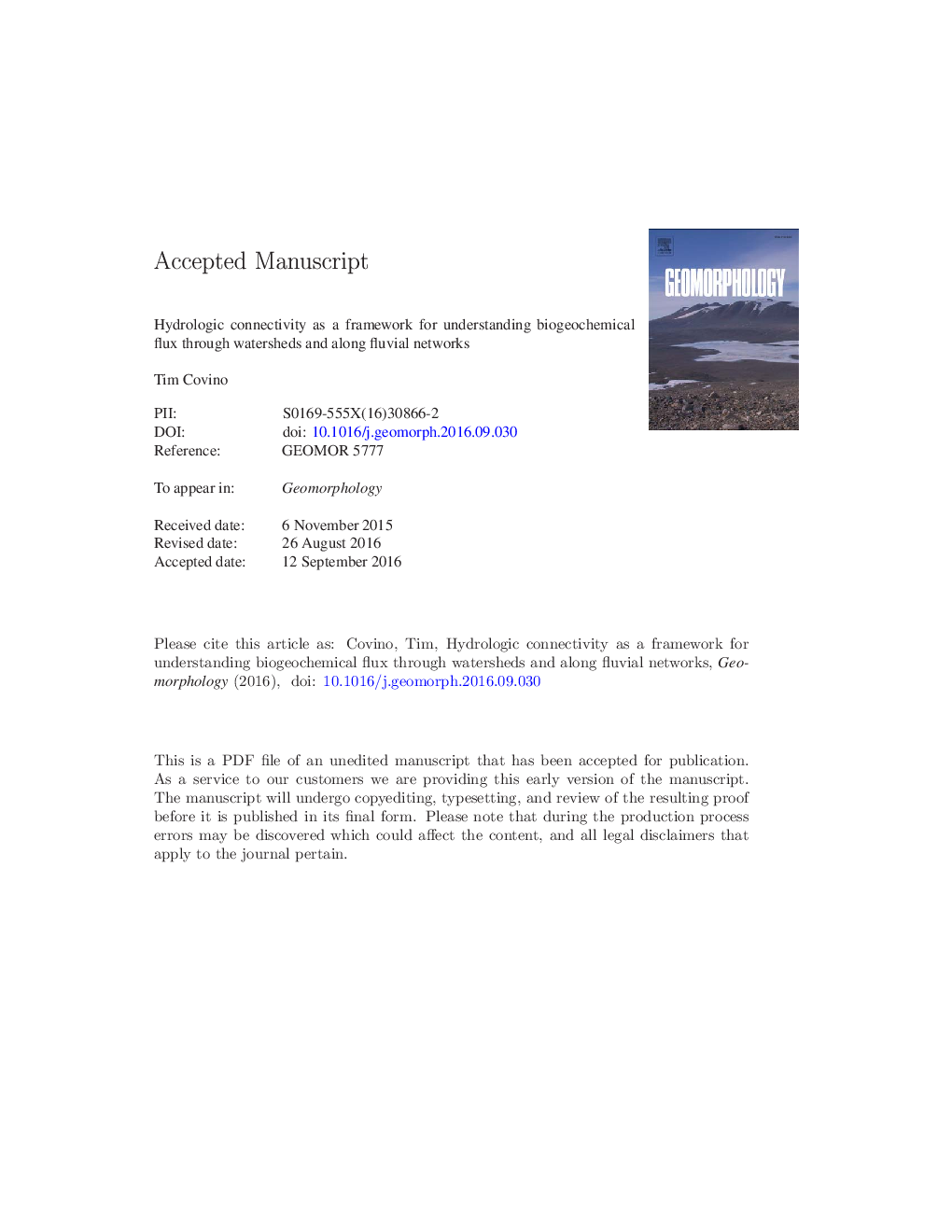| کد مقاله | کد نشریه | سال انتشار | مقاله انگلیسی | نسخه تمام متن |
|---|---|---|---|---|
| 5781141 | 1635372 | 2017 | 42 صفحه PDF | دانلود رایگان |
عنوان انگلیسی مقاله ISI
Hydrologic connectivity as a framework for understanding biogeochemical flux through watersheds and along fluvial networks
ترجمه فارسی عنوان
اتصال هیدرولوژیکی به عنوان یک چارچوب برای درک شار بیوگرافی شیمیایی از طریق حوزه های آبریز و در امتداد شبکه های رله
دانلود مقاله + سفارش ترجمه
دانلود مقاله ISI انگلیسی
رایگان برای ایرانیان
کلمات کلیدی
ترجمه چکیده
اتصالات هیدرولوژیکی می توانند تپه های تله را به شبکه های کانال، رودخانه ها به دریاچه ها، زیر زمین به سطح، زمین به جو، زمین به آب، و جریان آب به پایین دست پیوند دهند. این اتصالات می توانند در ابعاد عمودی، جانبی و طولی و مقیاس های فضایی و زمانی گسترش پیدا کنند. هر یک از این ابعاد و مقیاس ها به هم پیوسته است، ایجاد یک موزاییک از اتصالات هیدرولوژیکی توپی و فرآیندهای مرتبط. به نوبه خود، این فرآیندهای متقابل و ناهموار بر حمل و نقل، دوچرخه سواری و تبدیل مواد آلی و مواد مغذی معدنی از طریق حوزه های آبریز و در طول شبکه های رگبار تأثیر می گذارد. گرچه ارتباطات هیدرولوژیکی ابعاد و مقیاس های فضایی و زمانی را در بر می گیرد، روابط بین اتصال و کربن و پویایی مواد مغذی به ندرت در این چارچوب ارزیابی می شود. هدف از این مقاله ارائه یک دیدگاه متقابل انحصاری از اتصال هیدرولوژیکی است - برجسته اشکال مختلف اتصال اتصال هیدرولوژیکی که کنترل شار از مواد آلی و مواد مغذی - و کمک به تحریک یکپارچگی در مقیاس و ابعاد و همکاری بین رشته ها.
موضوعات مرتبط
مهندسی و علوم پایه
علوم زمین و سیارات
فرآیندهای سطح زمین
چکیده انگلیسی
Hydrologic connections can link hillslopes to channel networks, streams to lakes, subsurface to surface, land to atmosphere, terrestrial to aquatic, and upstream to downstream. These connections can develop across vertical, lateral, and longitudinal dimensions and span spatial and temporal scales. Each of these dimensions and scales are interconnected, creating a mosaic of nested hydrologic connections and associated processes. In turn, these interacting and nested processes influence the transport, cycling, and transformation of organic material and inorganic nutrients through watersheds and along fluvial networks. Although hydrologic connections span dimensions and spatiotemporal scales, relationships between connectivity and carbon and nutrient dynamics are rarely evaluated within this framework. The purpose of this paper is to provide a cross-disciplinary view of hydrologic connectivity - highlighting the various forms of hydrologic connectivity that control fluxes of organic material and nutrients - and to help stimulate integration across scales and dimensions, and collaboration among disciplines.
ناشر
Database: Elsevier - ScienceDirect (ساینس دایرکت)
Journal: Geomorphology - Volume 277, 15 January 2017, Pages 133-144
Journal: Geomorphology - Volume 277, 15 January 2017, Pages 133-144
نویسندگان
Tim Covino,
